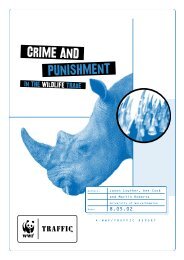4 <strong>Influencing</strong> <strong>Power</strong>IntroductionIntroduction1.01.1 Benchmarking Corporate LobbyingOver the past few years the number ofmajor companies picking up the corporateresponsibility (CR) 3 agenda has beensubstantial. As part of the work for thisreport, for example, we found that overthree-quarters (77) of the world’s 100largest companies now produce some formof stand-alone corporate responsibility orsustainability report. So widespread is thepractice, in fact, that while ten years agopioneering companies were remarkable forproducing such reports, today it’s the lackof reporting at the other 23 companies thatis more noteworthy.Despite this impressive rise in reporting bylarge companies, 4 substantive progress onthe big social and environmental challengeswe face remains elusive. We believe thislack of progress derives partly from the factthat CR is often an add-on — leaving corebusiness models and operations largelyuntouched; and partly from the fact thatmarket frameworks within whichcompanies operate do not provide thesignals needed to encourage companies toadopt more progressive practices. 5 This gapin market frameworks, in turn, is oftenattributed to government concern overbusiness resistance to new policies. As agroup of leading companies including BAA,BP, Cisco Systems and HSBC haveexplained with relation to climate change:‘The private sector and governments arecaught in a “Catch 22” situation . . .Governments tend to feel limited in theirability to introduce new policies forreducing emissions because they fearbusiness resistance, while companies areunable to take their investments in lowcarbon solutions to scale because of lackof long-term policies.’ 6This brief report builds on an initial paperproduced by SustainAbility and GovernmentPolicy Consultants (GPC) in 2000. Thatpublication, Politics and Persuasion, 7 madewhat was then seen as a bold claim — thatCR practices needed to be explicitly linkedwith a company’s lobbying and policyactivities. (See Panel 1.1 for an outline ofsuch activities.)At that time, the suggestion that these twoareas might be connected was widelyconsidered to be at best an unwelcome‘stretch’ for corporate responsibility, and atworst a harmful restraint on a legitimatebusiness practice. Five years on, thegrowing activity around this topic suggeststhat the scales are tipping in favour ofthose working to bring greater transparencyand responsibility to lobbying (see Section1.3).But although there has been a ground-swellin activity from NGOs, investors and othercommentators, progress within the businesscommunity has never, to our knowledge,been systematically analysed. 8 The first aimof our project is to address this gap bybenchmarking 100 of the world’s topcompanies on how they report on theirlobbying, and to derive recommendationson how this process could be improved. Thesecond aim is to move from a focus on‘conduct’ to look at ‘content’, and make thecase for companies to work withgovernments and other stakeholders inhelping shape public policy for sustainabledevelopment.Structure of the ReportSection1234IntroductionExplains the basicconcepts andbackground behindthis report.Our ApproachSets out the processused in reviewingcompany reports anddiscusses limitationsof the approach.Results andFindingsProvides the majorresults from theresearch as wellas our principleconclusions onthe conduct ofcorporate lobbying.Where NextSets out ourassessment ofwhy and howcompanies shouldadopt bestpractices in linkingCR with thecontent of theirlobbying.Figure 1.1
<strong>Influencing</strong> <strong>Power</strong>IntroductionA Complex and Contentious IssueAt this point it is worth emphasising thatlobbying is a complex area. At any one time,a multinational may be interacting withmany different policy-making bodiesaround the world through many differentmechanisms. From the US through the <strong>UK</strong>to France, Japan and China, the nature ofthe business–government interface variesenormously. The situation becomes evenmore complex in the context of conflict,failing states or societies in transition. Inaddition, interactions can take place atlocal, national, regional and internationallevels.We also recognise that lobbying can becontentious. For some, lobbying is part of acompany’s right to free speech. Increasinglyit is also acknowledged that effective publicpolicy — including on sustainabledevelopment — requires companies to takean active role. 9 Others argue that lobbyingundermines democracy due to thesignificant imbalance of power andresources between companies and otherentities, with companies perceived to bepursuing narrowly self-interested positionsat odds with the rest of society.This perspective was underlined as thisreport went to print, when revelations weremade concerning the close relationshipbetween ExxonMobil and the Bushadministration on climate change. 10 As oneGreenpeace activist put it, ‘The cynical wayto look at this is that ExxonMobil hasremoved its sleeper cell from the WhiteHouse and extracted him back to themother ship.’Undoubtedly, the reality is generally morenuanced, with companies needing toconsider costs and benefits as well as theneeds of other stakeholder groups in theirinteractions with policy-makers. But therelative lack of transparency aroundlobbying leads many to assume that whatcompanies communicate privately togovernment — either independently orthrough industry bodies — often conflictswith society’s best interests.Ultimately until this ‘black box’ of lobbyingis comprehensively opened up, allowing theinterface between private business andgovernments to be more transparent andbetter understood, trust — which has beenflagging for many years 11 — will remainelusive. We believe it is in the interest ofbusiness urgently to address such concerns.Who the Report is ForThe primary audience for the conclusionsand recommendations of this report is thebusiness community. Given the significanceof this issue for many stakeholders, animportant secondary audience consists ofinvestors (who seek out ‘responsible’companies or want to understand politicalrisks), governments (who set policy andregulate business), NGOs (who both act aswatchdogs of business and influence publicpolicy themselves) and trade associationsand professional lobbyists (both of whomlobby on behalf of companies).1.2 The Scale of Corporate LobbyingTo provide some perspective on the scale ofcorporate influence on government andpublic policy we turn to the US, wheredisclosure laws mean more information isavailable. It is estimated that during the2004 US election cycle, donors withbusiness interests contributed US$1.5billion to politicians and political parties. 12This scale of corporate campaign financehas led to much concern and somelegislative reform (see Panel 3.2).Lobbying and Other PublicPolicy ActivitiesThis report considers a range of corporateactivities or decisions which are intendedto influence public policy. These includeefforts to:— influence the outcome or direction ofproposed or existing legislation.— influence how regulators apply orenforce existing laws.— influence the broad direction of publicpolicy, whether at the local, national orinternational (e.g. through the UN orWorld Trade Organisation) level.5— support (either directly or indirectly)external organisations including industryassociations, chambers of commerce,think-tanks, NGOs, etc. that seek toinfluence public policy.— develop or improve the company’srelationships with government officials,civil servants or the judiciary.— support political candidates orincumbents through, for example,monetary donations or other formsof support.These activities go beyond just ‘lobbying’and may include, for example, relativelyneutral engagement between business andgovernment without business seeking aparticular outcome. However, to keep thelanguage simple we have chosen to use thecommon term ‘lobbying’ instead of abroader alternative like ‘corporate publicpolicy activity’.Panel 1.1


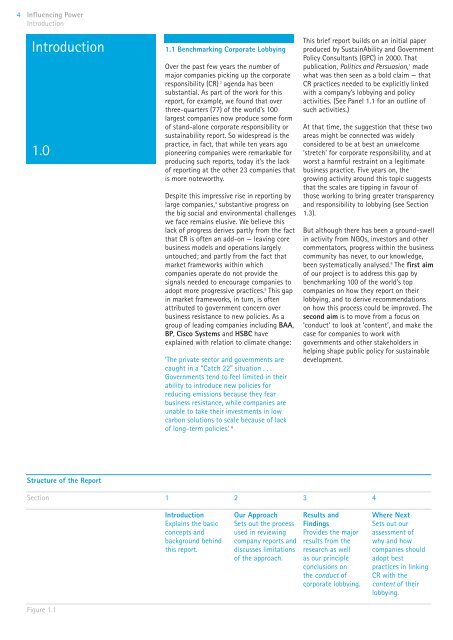

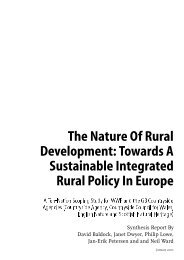
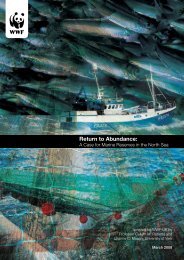



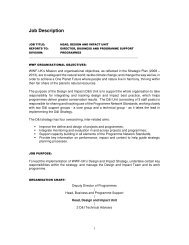

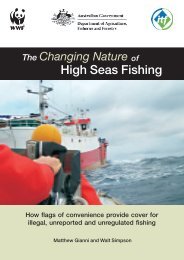

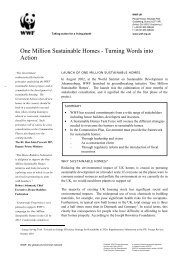
![[PDF] Causes for concern: chemicals and wildlife - WWF UK](https://img.yumpu.com/31929970/1/184x260/pdf-causes-for-concern-chemicals-and-wildlife-wwf-uk.jpg?quality=85)
